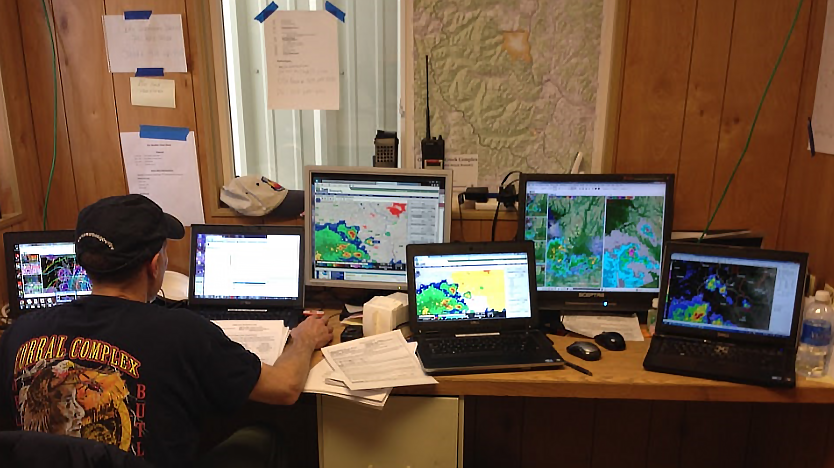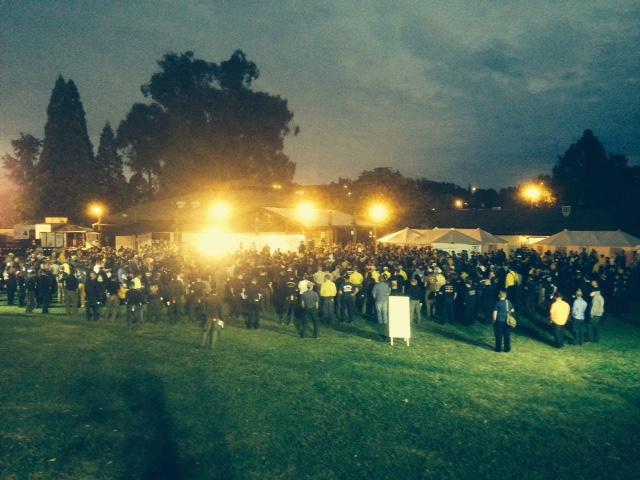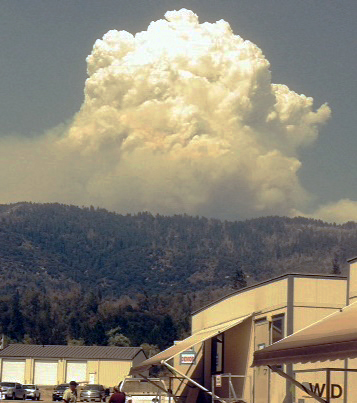
The set-up for an IMET who is keeping tabs on the weather at a fire incident.
When you think of the role NOAA’s National Weather Service (NWS) plays in hazardous weather, you may think of the forecasts they produce or the Watches and Warnings they issue leading up to a storm. What you may not realize is that the NWS has eyes on the sky before, during and after some of the country’s most dangerous weather.
On average each year, wildfires kill 30 people, destroy 2,800 homes and burn more than seven million acres. The annual average cost for damages and suppression of wildland fire is more than $2 billion. Smoke from wildfires also causes numerous health issues. Breathing in smoke produced by wildfire can be extremely hazardous, particularly for children and older adults.
Meteorologists from NWS work on the front lines to support agencies who prevent and fight wildfires, collaborating closely with state and local fire control agencies, as well as the Forest Service and other federal agencies.
Wildfires are not weather. However, weather conditions influence how easily a fire may start, how quickly it spreads and where the fire (and smoke) will move. Lightning strikes in dry areas are a common cause of these fires.
Incident Meteorologists (IMETs) help keep the fire crews safe by enabling responders to plan operations taking into account one of the most variable aspects of the incident — the weather. They are NWS Forecasters who have been specially trained and certified to provide weather support at a fire location.
IMETs keep firefighters safe by interpreting weather information, assessing its effect on the fire and communicating it to fire crews. Once on-site, IMETs become key members of the incident command teams and provide continuous meteorological support for the duration of the incident.
IMETs are located in numerous NWS offices across the country. Once a large wildfire has started, an IMET is contacted and given orders to travel to the site of the fire as quickly as possible. Ken Simosko, an IMET with the NWS Bismarck Weather Forecast Office (WFO), has worked five fire incidents. “You have to be ready at a moment’s notice. I have my bag ready to go so that when I get the call, I can spend my time getting spun up on the history of the fire, its current and future situation. Usually an IMET is on scene within 24 hours to 48 hours of the initial call. This depends on the mode of travel [car or plane] and how far the IMET is from the wildland fire.”
At the fire site, the IMETs check in at the incident command center. This is usually located relatively near the active wildfire and is either part of a temporary tent or trailer camp that is set up for those who are working the event. “Depending on the size of the fire there can be hundreds of folks involved. Some people bring tents to sleep in. I usually bring a blow-up mattress and sleep in the back of my truck. The command center supplies food and brings in shower and bathroom facilities on a flatbed for all of us who are working the event,” says Simosko.
Each IMET deployment lasts around two weeks, or until the wildfire is considered contained. If a fire lasts more than two weeks, another IMET will be sent to relieve the one who has just completed their two weeks on-site. There is very little “down time” when working a wildfire.
|
 Morning crew briefing at the King Fire in El Dorado County, California. Morning crew briefing at the King Fire in El Dorado County, California. |

Proximity of the command center to a fire incident.
As the day goes on, an IMET’s duties shift a bit more heavily towards forecasting, especially if there is a chance of thunderstorms. In the areas where large wildfires tend to occur, thunderstorms don’t necessarily bring much rain, but they do bring plenty of lightning. “If thunderstorms are in the forecast, you’re tied to your workstation, watching the storms on radar once they have started, and updating the forecast as needed” says Clapp. The safety of the crews working the fire is paramount so when lightning is in the area they are pulled back to a safe location. Wind is another dangerous element of thunderstorms. Strong gusts can cause the fire to suddenly shift, which can injure the firefighters or cut off their way back to safety.
Simosko noted that forecasting for a wildfire incident is very different from the general weather forecasts he issues in the office. “[I’m] focusing on a much smaller area and a shorter time period. Because the forecasts are being used within minutes to hours, I get immediate feedback on how I did,” says Simosko. Both Simosko and Clapp appreciate the immediate feedback. It challenges them both to continually strive to make the best forecast possible.
As more Americans move into areas prone to wildfires, the importance of the IMET program will continue to grow. You can help fire crews by following instructions from authorities during a wildfire. If ordered to evacuate, do so promptly. Make sure you have an emergency preparedness kit including three days of food, water and other supplies. Talk to your family about how they will communicate during an emergency. Simple steps such as these will help keep you safe and connected during a wildfire emergency.